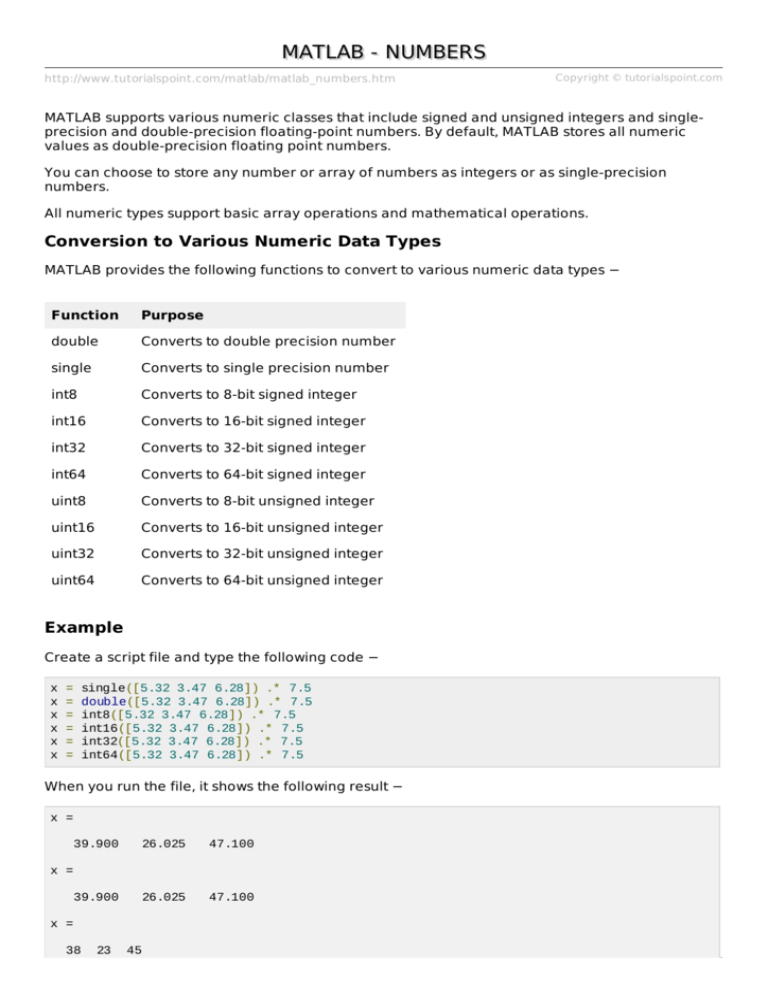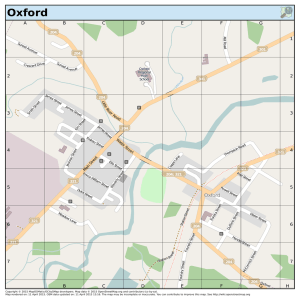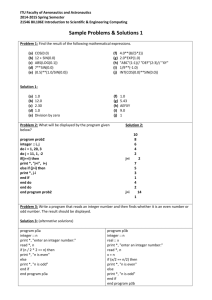MATLAB Numbers - TutorialsPoint
advertisement

MATLAB - NUMBERS
http://www.tutorialspoint.com/matlab/matlab_numbers.htm
Copyright © tutorialspoint.com
MATLAB supports various numeric classes that include signed and unsigned integers and singleprecision and double-precision floating-point numbers. By default, MATLAB stores all numeric
values as double-precision floating point numbers.
You can choose to store any number or array of numbers as integers or as single-precision
numbers.
All numeric types support basic array operations and mathematical operations.
Conversion to Various Numeric Data Types
MATLAB provides the following functions to convert to various numeric data types −
Function
Purpose
double
Converts to double precision number
single
Converts to single precision number
int8
Converts to 8-bit signed integer
int16
Converts to 16-bit signed integer
int32
Converts to 32-bit signed integer
int64
Converts to 64-bit signed integer
uint8
Converts to 8-bit unsigned integer
uint16
Converts to 16-bit unsigned integer
uint32
Converts to 32-bit unsigned integer
uint64
Converts to 64-bit unsigned integer
Example
Create a script file and type the following code −
x
x
x
x
x
x
=
=
=
=
=
=
single([5.32 3.47 6.28]) .* 7.5
double([5.32 3.47 6.28]) .* 7.5
int8([5.32 3.47 6.28]) .* 7.5
int16([5.32 3.47 6.28]) .* 7.5
int32([5.32 3.47 6.28]) .* 7.5
int64([5.32 3.47 6.28]) .* 7.5
When you run the file, it shows the following result −
x =
39.900
26.025
47.100
39.900
26.025
47.100
x =
x =
38
23
45
x =
38
23
45
23
45
23
45
x =
38
x =
38
Example
Let us extend the previous example a little more. Create a script file and type the following code −
x = int32([5.32 3.47 6.28]) .* 7.5
x = int64([5.32 3.47 6.28]) .* 7.5
x = num2cell(x)
When you run the file, it shows the following result −
x =
38
23
45
23
45
x =
38
x =
{
[1,1] = 38
[1,2] = 23
[1,3] = 45
}
Smallest and Largest Integers
The functions intmax and intmin return the maximum and minimum values that can be
represented with all types of integer numbers.
Both the functions take the integer data type as the argument, for example, intmaxint8 or intmin
int64 and return the maximum and minimum values that you can represent with the integer data
type.
Example
The following example illustrates how to obtain the smallest and largest values of integers. Create
a script file and write the following code in it −
% displaying the smallest and largest signed integer data
str = 'The range for int8 is:\n\t%d to %d ';
sprintf(str, intmin('int8'), intmax('int8'))
str = 'The range for int16 is:\n\t%d to %d ';
sprintf(str, intmin('int16'), intmax('int16'))
str = 'The range for int32 is:\n\t%d to %d ';
sprintf(str, intmin('int32'), intmax('int32'))
str = 'The range for int64 is:\n\t%d to %d ';
sprintf(str, intmin('int64'), intmax('int64'))
% displaying the smallest and largest unsigned integer data
str = 'The range for uint8 is:\n\t%d to %d ';
sprintf(str, intmin('uint8'), intmax('uint8'))
str = 'The range for uint16 is:\n\t%d to %d ';
sprintf(str, intmin('uint16'), intmax('uint16'))
str = 'The range for uint32 is:\n\t%d to %d ';
sprintf(str, intmin('uint32'), intmax('uint32'))
str = 'The range for uint64 is:\n\t%d to %d ';
sprintf(str, intmin('uint64'), intmax('uint64'))
When you run the file, it shows the following result −
ans = The range for int8 is:
-128 to 127
ans = The range for int16 is:
-32768 to 32767
ans = The range for int32 is:
-2147483648 to 2147483647
ans = The range for int64 is:
0 to 0
ans = The range for uint8 is:
0 to 255
ans = The range for uint16 is:
0 to 65535
ans = The range for uint32 is:
0 to -1
ans = The range for uint64 is:
0 to 18446744073709551616
Smallest and Largest Floating Point Numbers
The functions realmax and realmin return the maximum and minimum values that can be
represented with floating point numbers.
Both the functions when called with the argument 'single', return the maximum and minimum
values that you can represent with the single-precision data type and when called with the
argument 'double', return the maximum and minimum values that you can represent with the
double-precision data type.
Example
The following example illustrates how to obtain the smallest and largest floating point numbers.
Create a script file and write the following code in it −
% displaying the smallest and largest single-precision
% floating point number
str = 'The range for single is:\n\t%g to %g and\n\t %g to
sprintf(str, -realmax('single'), -realmin('single'), ...
realmin('single'), realmax('single'))
% displaying the smallest and largest double-precision
% floating point number
str = 'The range for double is:\n\t%g to %g and\n\t %g to
sprintf(str, -realmax('double'), -realmin('double'), ...
realmin('double'), realmax('double'))
When you run the file, it displays the following result −
ans = The range for single is:
-3.40282e+38 to -1.17549e-38 and
1.17549e-38 to 3.40282e+38
ans = The range for double is:
-1.79769e+308 to -2.22507e-308 and
2.22507e-308 to 1.79769e+308
Loading [MathJax]/jax/output/HTML-CSS/fonts/TeX/fontdata.js
%g';
%g';
![[#PF-1998] subordintated taxa of Xenillidae](http://s3.studylib.net/store/data/007613529_2-36b265815b5d8ce7df1b35bae74e1254-300x300.png)



